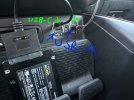two ways:
1. run 12 or 10 AWG power and ground through firewall, attach to a Blue Sea Fuse Block with Ground. In the engine bay, body ground and use a Blue Sea Circuit Breaker (40A should be plenty enough with rooms for future upgradability short of a high output DC-DC charger). This wayy, you can manually disconnect it while the vehicle is not running so you do not drain the battery. Remember, BLUE SEA EVERYTHING. Not the cheap chinese knockoffs. If you want to run chinese knock offs, double the Amperage rating because china spec.
2. run 12 or 10 AWG power and ground through the firewall, attach to Blue Sea Fuse Block with Ground. In the engine bay, utilize a 40A relay system. Power from battery with inline fuse, body ground it. Attach 12v trigger to something ign switched in the fuse box and connect the 10 or 12 AWG power and ground to the relay output. This way, the relay will complete the circuit and feed power to the unit only when the ignition is on, and cut power when the ignition is off.
Then, attach USB-C outlet to the Blue Sea Fuse Block with Ground and connect it accordingly, or if it has a split pigtail just connect it accordingly.
But the question is, why do you need to run starlink when driving? Like, if you need navigation, there's Gmap offline mode, there's Gaia GPS, there's OnX, there's stand-alone GPS units, and there's in-dash unit. If you need emergency contact, then Garmin inReach is one of the few solid choices. I just completed 12.7k miles to Alaska and Arctic Ocean. Majority of that trip, other than in southern/ populated areas of AK and lower 48, which maybe accounting for 5k miles of the entire trip at best, I had no cell signal (no cell signal in Canada because I turned it off to not incur international roaming charges), and there was zero problem navigating the remaining 7.7k miles of the most remote areas. I only ran starlink at night at camp, not when i was driving. so it made me really curious why is there a need to run starlink while driving?












